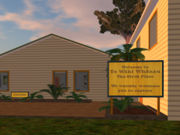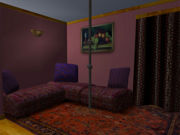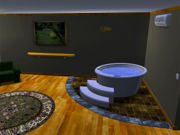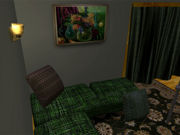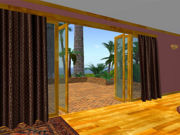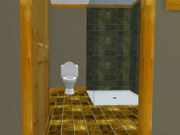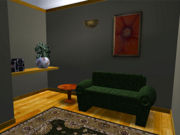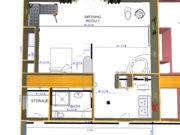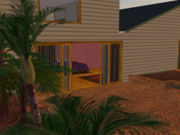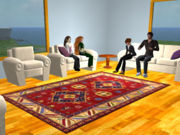The making of Te Wāhi Whānau
<kaltura-widget kalturaid='2jx7i2fl6t' size='L' align='R'/>
Welcome to the making of Te Wāhi Whānau - the virtual birthing unit. This video tells the story of how the unit was designed, why it was built in Second Life, and what we hope it will achieve. To the right is a copy of the video you can play now. If you'd prefer, you can get copies of this video, its audio, images used and a text version of the audio below.
Downloads
- The video on Youtube
- Download video in a higher resolution WMV format
- The audio on Blip.tv
- Download the audio in higher resolution WAV format
- Still frame images from the video in a zip archive file
Transcript
Professor Maralyn Foureur (MF): What we're building, in terms of birth spaces in hospitals, are actually pathological spaces, built to house medically managed child birth. The spaces very much function to assist the medical technicians to do things to women, rather than spaces that allow for labour and birth to unfold the way women want.
Music by Gurdonark (Music G): http://ccmixter.org/files/gurdonark/13243
Professor Carolin Homer (CH): We know from being midwives in practice, we've always changed the spaces to try and accommodate women. We've always tried to turn the lights down, make things warm, use water, keep women off the bed. We've always tried to change the environment. So it seems a sensible thing to think about how can you make the environment the best it could be for women.
Professor Nicky Leap (NL): And I remember speaking to a midwife in the Netherlands, about how when we transfer women into hospital, we start behaving differently because of the environment. Its much harder to be focused on the woman, because you're in a hospital environment, but its more than that. Its about the whole feeling of the place, in terms of how centered you are on that woman. When you work as a home birth midwife, as I did for 15 years, you notice where the women give birth. You notice how they move around, and in my experience, women never gave birth in the bedroom, they very often gave birth in the smallest room in the house without windows - because it was the most private, like in the loo or the bathroom, and often in the sitting room.
Professor Ian Forbes (IF): My role really was to look at principles, design principles for spaces, about what women want from birthing spaces. My role then was, if these are the sorts of spaces that people should have, what are the criteria by which we would then say, this is a good or a bad space. A lot of those are value terms, it really does come to trying to say what is essential in a physical space.
CH: So there's a number of components to having a safe satisfying birth. One is model of care, one is the environment, and one is how the care givers interact with one another, and I think that is really mediated by environment.
Professor Claire Atkins (CA): The Tertiary Education Commission in New Zealand, announced a particular - a special fund, for encouraging and supporting innovation for tertiary education. It was to this fund that we actually applied believing that we were certainly innovative if nothing else.
Sarah Stewart (SS): We were very keen to get involved with the Second Life Education New Zealand project because we wanted to create another avenue for students and midwives to explore the issues that face them in practice.
Music G: http://ccmixter.org/files/gurdonark/20064
Aaron Griffiths: At stage one of this project, we're looking at very basic interaction, in terms of showing people visually what the design is about, and directing them in a number of ways to different bits of information. Where as stage 2 and stage 3, we're looking at a lot more immersion it terms of students and facilitators being able to interact with each other as people in the environment.
SS: Many students don't have the opportunity to work with women in their home environment, and many don't even get the chance to work in primary units. They often work in tertiary units, that are very medicalised, and where the rates of medical intervention are very high. Caesarean sections, forceps, epidurals, and some students have very little exposure to normal birth - and yet that's ridiculous, because as midwives that's exactly what we should be expert at. So by creating a birthing unit in Second Life it gives students the opportunity to see the ideal. To see how the birthing unit should be set out, to see how the environment should be set out for women to birth in, and for them as midwives to work in - in a way that they don't get the opportunity to in real working life.
Deborah Davis: This project is about bring the birth unit design principles to life. It was important for us that people, including our midwifery students or other people, could walk through the unit and not only see a beautiful space, but to be informed about the importance of the design features for the child bearing experience. So they can understand why we've chosen the certain colours that we have, why we have the particular sorts of art work on the walls. Why, for example, there's a large living area and kitchen. Why you don't walk immediately into the main birthing area, but into an anti room. Why there's a large pool. What's the evidence around water immersion and labour and birth. And better still, they won't just be able to see and be informed, but they'll be able to immerse themselves in this environment.
SS: But its more than just building a birthing unit, the thing that I am very excited about is that it's a place to meet students, other midwives, and the general public, to connect with people. It's not just there for one class, it's there for people to use, it's Creative Commons licensed - which means anybody can come in and use it, and use the resources that we've put there, and that again is an exciting innovation for us in midwifery education.
